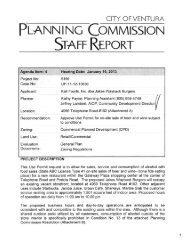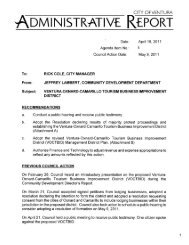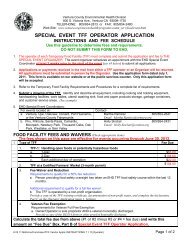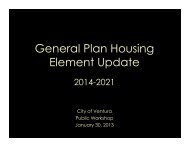Saticoy & Wells Community Plan & Development ... - City Of Ventura
Saticoy & Wells Community Plan & Development ... - City Of Ventura
Saticoy & Wells Community Plan & Development ... - City Of Ventura
You also want an ePaper? Increase the reach of your titles
YUMPU automatically turns print PDFs into web optimized ePapers that Google loves.
<strong>Saticoy</strong> & <strong>Wells</strong> <strong>Community</strong> <strong>Plan</strong> and Code EIRSection 4.8 Hydrology and Water Qualitythe impervious roadway surfaces could enter the surface water bodies including the Brown andFranklin Barrancas and the Santa Clara River.Construction activities could also result in the pollution of natural watercourses orunderground aquifers. The types of pollutant discharges that could occur as a result ofconstruction include accidental spillage of fuel and lubricants, discharge of excess concrete, andan increase in sediment runoff.It should be noted that agricultural uses within the Project Area may involve the application ofpesticides and other chemicals. Storm runoff from these agricultural fields rechargesgroundwater and also discharges into local water bodies. The replacement of agricultural landwith urban uses could result in the reduction in discharge of agriculturally-related pollutants,including pesticide runoff, into nearby surface water bodies and the placement of impervioussurfaces at the sites would reduce the amount of sediment conveyed to surface water throughstormwater runoff.Discharge of pollutants from any point source is prohibited unless it is in compliance with theNational Pollutant Discharge Elimination System (NPDES) Permit issued by the Regional WaterQuality Control Board. Point sources of pollutants of greatest concern include nutrients(ammonia and nitrate), heavy metals, toxic chemicals, chlorine, and salts. Non-point sources ofpollutants, which are also regulated under NPDES permits, include both construction-relatedrunoff and operational runoff associated with urban uses. Surface runoff from individual sitesis carried to <strong>City</strong> storm drains and/or natural drainages.Regulations under the federal Clean Water Act require that projects that would disturb greaterthan one acre during construction comply with the statewide NPDES general constructionstorm water permit. Compliance with the NPDES permit is dependent on the preparation of aStorm Water Pollution Prevention <strong>Plan</strong> (SWPPP) that contains specific actions, termed BestManagement Practices (BMPs), to control the discharge of pollutants, including sediment, intothe local surface water drainages. In the State of California, Regional Water Quality ControlBoards administer the NPDES permit process. <strong>Development</strong> facilitated by the Project would berequired to comply with the most recent NPDES requirements at the time of developmentapproval.As discussed in the Setting, the <strong>Ventura</strong> County SQUIMP applies to the operational runoff andrequires new developments and redevelopment projects to implement various BMPs tominimize the amount of pollutants entering surface waters. All projects that fall into one ofeight categories are identified in the <strong>Ventura</strong> Countywide Municipal Permit as requiringSQUIMPs. These categories include: (1) single family hillside residences; (2) 100,000 squarefoot commercial developments; (3) automotive repair shops; (4) retail gasoline outlets; (5)restaurants; (6) home subdivisions with 10 or more housing units; (7) location within or directlyadjacent to or discharging directly to an environmentally sensitive area; and (8) parking lotswith 5,000 square foot or more impervious parking or access surfaces with 25 or more parkingspaces and potentially exposed to stormwater runoff.4.8-13<strong>City</strong> of <strong>Ventura</strong>
















